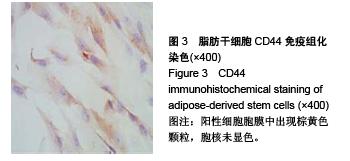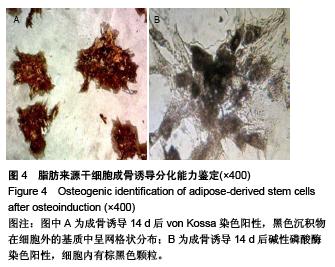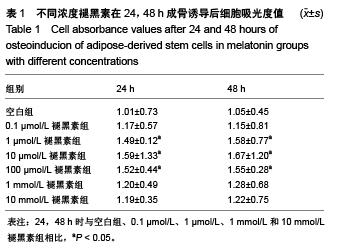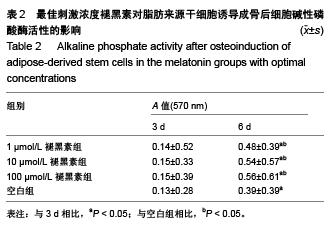| [1] Zuk PA, Zhu M, Mizuno H, et al. Multilineage cells from human adipose tissue: implications for cell-based therapies. Tissue Eng. 2001;7(2):211-228.[2] 梁笃,樊粤光,王海彬,等.成人脂肪来源干细胞定向诱导分化为软骨细胞的实验研究[J].广州中医药大学学报,2009,26(4): 412-418.[3] 徐丽丽,孙晓娟,郝秀仙,等. 在复合成分培养基中骨髓间充质干细胞的诱导成骨[J].中国组织工程研究,2015,19(10):1501- 1505.[4] 李龙,赵建辉,刘斌,等.兔脂肪干细胞的分离培养鉴定及诱导分化研究[J].口腔医学研究,2012,28(5):426-429.[5] 刘琴,王丽平,喻晶,等.组织块贴壁法扩增兔脂肪干细胞[J].中国组织工程研究,2014,18(1):88-93.[6] Cuzzocrea S, Reiter RJ. Pharmacological actions of melatonin in acute and chronic inflammation. Curr Top Med Chem. 2002;2(2):153-165.[7] Azeddine B, Letellier K, Wang da S, et al. Molecular determinants of melatonin signaling dysfunction in adolescent idiopathic scoliosis. Clin Orthop Relat Res. 2007;462:45-52.[8] Sánchez-Barceló EJ, Mediavilla MD, Tan DX, et al. Scientific basis for the potential use of melatonin in bone diseases: osteoporosis and adolescent idiopathic scoliosis. J Osteoporos. 2010;2010:830231.[9] Amstrup AK, Sikjaer T, Mosekilde L,et al. Melatonin and the skeleton. Osteoporos Int. 2013;24(12):2919-2927.[10] Man GC, Wang WW, Yeung BH, et al. Abnormal proliferation and differentiation of osteoblasts from girls with adolescent idiopathic scoliosis to melatonin. J Pineal Res. 2010; 49(1): 69-77.[11] Solá-Ruiz MF, Pérez-Martínez C, Martín-del-Llano JJ, et al. In vitro preliminary study of osteoblast response to surface roughness of titanium discs and topical application of melatonin. Med Oral Patol Oral Cir Bucal. 2015;20(1):e88-93.[12] Xiong XC, Zhu Y, Ge R, et al. Effect of Melatonin on the Extracellular-Regulated Kinase Signal Pathway Activation and Human Osteoblastic Cell Line hFOB 1.19 Proliferation.Int J Mol Sci. 2015;16(5):10337-10353.[13] Sun X, Shao Y, Jin Y, et al. Melatonin reduces bacterial translocation by preventing damage to the intestinal mucosa in an experimental severe acute pancreatitis rat model. Exp Ther Med. 2013;6(6):1343-1349.[14] 付洁,宋海岩,马传飞,等.褪黑素促进体外缺氧的神经干细胞增殖及定向分化[J].神经解剖学杂志,2015,31(1):37-43.[15] 丁华,袁志诚,耿荣科,等.骨髓间充质干细胞移植联用褪黑素对大鼠脊髓损伤修复的影响[J].郧阳医学院学报,2010,29(1):4-8.[16] Zaminy A, Ragerdi Kashani I, Barbarestani M, et al. Osteogenic differentiation of rat mesenchymal stem cells from adipose tissue in comparison with bone marrow mesenchymal stem cells: melatonin as a differentiation factor. Iran Biomed J. 2008;12(3):133-141.[17] Sethi S, Radio NM, Kotlarczyk MP, et al. Determination of the minimal melatonin exposure required to induce osteoblast differentiation from human mesenchymal stem cells and these effects on downstream signaling pathways. J Pineal Res. 2010;49(3):222-238.[18] 何银锋,张鹏,赵国阳,等.铁过载对成骨细胞铁稳态及生物活性的影响[J].中华骨质疏松和骨矿盐疾病杂志,2013,6(1):37-43.[19] Zaminy A, Kashani IR, Barbarestani M, et al. Effects of melatonin on the proliferation and differentiation of rat adipose-derived stem cells.Indian J Plast Surg. 2008;41(1): 8-14. |





